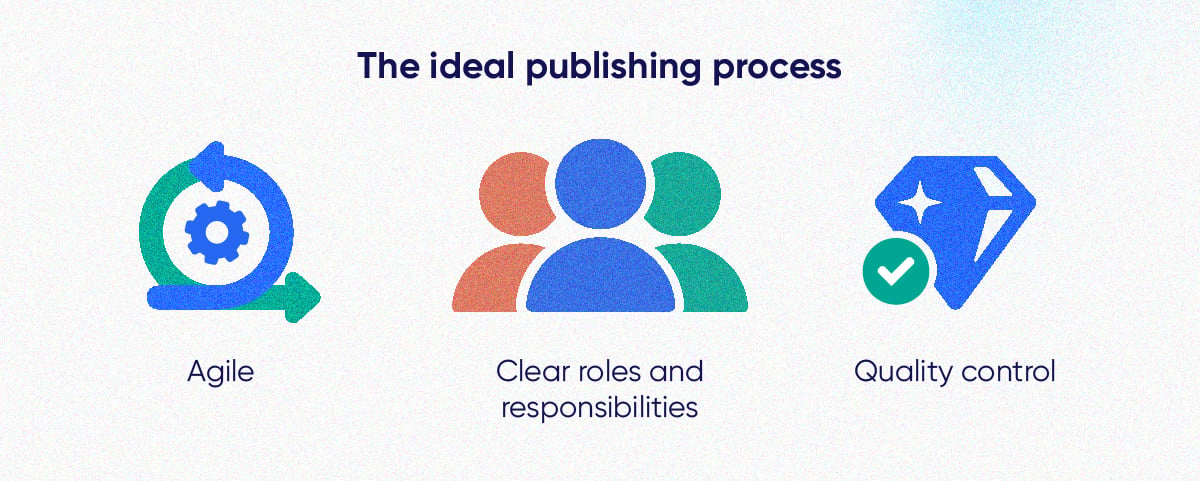If you haven’t noticed, online audiences don’t waste any time deciding whether your content is relevant to them or not. One study found that people visiting a web page only stay on the page for an average of 10-20 seconds.
But that’s if they visit your page at all. The latest numbers from 2020 show that 90% of organic content on Google does not reach its intended audience.

What can marketing leaders do to make sure their teams are producing relevant content that leads to real results and doesn’t just throw fuel on the fire? They need to make sure their teams produce less content—and instead focus on optimizing for quality.
Scale back quantity to scale up results
Unfortunately, high-producing is often mistaken for high-performing. What separates a high-producing team from a high-performing team? Any guesses? Intention.
Is it busy work or smart work?
High-producing teams are what happens when a company treats marketing like a drive-thru service. They churn out content for every campaign, initiative, and request that comes across their desk—leaving them burned out. They’re focused on short term results and grabbing quick wins.
There’s no shame in a good hustle , but when most of your time is spent executing, you can easily find yourself on a hamster wheel chasing results. The thing about a hamster wheel is you can’t change direction once you’re on it. And that’s a problem when your audience’s needs are constantly in flux.
Be intentional, be consistent
In contrast, high-performing teams use more time to map out the purpose of a content piece during the brainstorm phase before jumping into execution mode. They ask themselves, what is stopping our audience from reaching their goals and how can our content help? How does our content align with our own company’s messaging and goals? And what data do we have to draw on (and more importantly, how can we act on that data to point us in the right direction)?

Producing less and optimizing more is by no means the easy way out. Because it’s not just about optimizing the content itself, but also optimizing how your content teams work with other teams both in and out of marketing. In a study commissioned by LinkedIn, they found that nine in ten sales and marketing professionals say they are misaligned across strategy, process, content and culture.
And that’s a shame, because input from your salespeople could unlock a whole new perspective on what your audience wants. This is crucial information you can use in your content strategies.
Setting up a transparent feedback loop and quality assurance checks takes an intentional effort too. Having a system in place is a safety net for your teams. The payoff is everyone can trust that your content meets brand and quality standards, and your team can focus on more of the brainwork.
Optimizing your MarTech stack and centralizing data
Another way to help your team become high-performing is to make sure you’re using your marketing tools more effectively. Only 33% of organizations feel their MarTech stack meets their business needs, according to Gartner.
To avoid this problem, consolidating your MarTech stack ensures you use each tool to its full potential. Having a tool for each specific task may sound good in theory, but in practice it leads to siloed information, broken visibility, and more costs for each individual tool. In fact, over 63% of CMOs project their budgets for MarTech will inflate as new tech like generative AI keeps emerging, becoming more and more innovative.
And although it’s tempting to jump on new trends, just remember that when it comes to building a well-oiled MarTech stack for your teams, the make-or-break factors to look for are: how seamless the tools integrate with one another and how centralized your data is.
Framework makes the team work
Making the shift from high-producing to high-performing is like making an omelet, because you can’t do it without breaking some eggs. Or in this case, breaking some habits.
Surprisingly (or perhaps not), a report from Gartner states that “less than 40% of marketers who engage in content marketing have a defined and documented strategy”. The first habit to break, then, is diving into content production without a gameplan.
Avoid this by setting up frameworks for each step of the content product cycle, so your teams can go from ideation, to drafting, editing, publishing, and promoting content without having to stop and ask for directions.
These frameworks are going to look unique to your company, your teams, how you work, and what your goals are. But there are three guiding elements that any airtight publishing process should have in place.

Think agile
Agile teams define, create, and evaluate continuously. The advantage of this is that you catch any potential issues sooner, rather than later, and can adjust course as needed. Apply this not just to your content, but to yourselves as a team.
Map out clear roles and responsibilities
As a marketing leader, you need to make sure everyone understands their role in the content production process. For instance, who is responsible for gathering input and feedback from stakeholders and who is accountable for quality assurance.
Put solid quality control in place
It can be easy to slip into bad habits without putting in some checkpoints to ensure your content quality stays consistently up to snuff. Do yourself a favor and invest in a solution that automates the more monotonous tasks of checking for errors.
The content game is evolving and so should marketing leaders
There was a time when content played the supporting role for the communication that sales teams were already having with customers via face-to-face or over the phone conversations. But the game has changed and keeps changing.
Every word on your homepage or social media post bears more weight because this is where the conversations start. But it can also be where the conversations end. According to PWC’s findings, 32% of the customers would leave a brand they loved after just one bad experience.
This mounting pressure could explain why a report from Gartner states that “50% of marketers cite a desire for perfection as one of their top obstacles to content production ”. Maybe perfection is too far a stretch to maintain, but what is certain is that quality content is created by confident content teams.
And it is up to marketing leaders to help create a culture that builds confident teams—to focus less on output and more on the optimization process. Because what worked for you a month ago, isn’t necessarily what will work next quarter.

